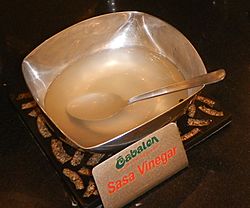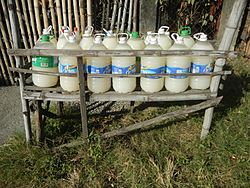Nipa palm vinegar facts for kids
 
Top: Nipa palm vinegar at a buffet;
Bottom: Homemade nipa palm vinegar being sold in Paombong, Bulacan |
|
| Alternative names | nipa vinegar, sukang sasa, sukang nipa, sukang Paombong |
|---|---|
| Type | condiment, ingredient |
| Place of origin | Philippines |
| Main ingredients | Nipa palm sap |
Nipa palm vinegar, also called sukang sasâ or sukang nipa, is a special kind of vinegar from the Philippines. It's made from the sweet liquid, called sap, that comes from the nipa palm tree.
This vinegar is one of the four main types of vinegars found in the Philippines. The others are coconut vinegar, cane vinegar, and kaong palm vinegar. You might often see it simply labeled as "palm vinegar" in stores.
Nipa palm vinegar is very important to Filipino food culture. It's even listed in the Ark of Taste. This is an international list of special foods that are in danger of disappearing. Sadly, traditional vinegars like this one are threatened by the rise of vinegars made in big factories.
Contents
What is Nipa Palm Vinegar Called?
In the Philippines, nipa palm vinegar has several local names. It's known as sukang sasa or sukang nipa. Both nipa and sasa are native names for the nipa palm tree in the Tagalog language. The word sukâ means "vinegar."
It's also famous as sukang Paombong. This name comes from the town of Paombong, Bulacan. Making this vinegar is a big tradition there. The town's name, Paombong, might even come from the Tagalog word bumbóng. This word means "bamboo tube." Bamboo tubes were traditionally used to collect the nipa sap before plastic or glass containers became common.
Sometimes, it's called sukang tubâ. Tubâ is a general term for palm toddy. This is a drink made from the sap of different palm trees in the Philippines. These include the coconut, buri palm (Corypha elata), and kaong palm (Arenga pinnata).
How is Nipa Palm Vinegar Made?
Nipa palm vinegar starts with sap collected from mature nipa palms. These trees usually grow in muddy areas next to salty rivers and estuaries.
To get the sap, workers cut the stalk of the nipa palm. Then, they place a container underneath to catch the dripping sap. In the past, these containers were often bamboo tubes. Harvesters might shake or kick the base of the leaves. This helps the sap flow out better. They might also bend the stalk to make it easier to collect.
The sap is collected twice a day as the containers fill up. However, during dry seasons, it might take longer for the containers to fill.
The Fermentation Process
Once collected, the sap is put into large earthen jars called tapayan. These jars are traditionally used for fermentation. Fermentation is a natural process where tiny living things, like wild yeast, turn the sugars in the sap into ethanol. This first step turns the sap into a traditional palm toddy called tubâ.
If the tubâ is left to ferment even longer, something else happens. Tiny bacteria called Acetobacter from the air get involved. They change the ethanol into acetic acid, which is what makes vinegar sour. The vinegar is ready when its sourness reaches about four or five percent.
Making nipa palm vinegar usually takes about two to three weeks. If a special "starter" of yeast is added, the process can happen even faster.
What Makes Nipa Palm Vinegar Special?
Nipa palm sap has a lot of sugar, usually between 15% and 22%. This high sugar content makes nipa palm vinegar a bit sweeter than coconut vinegar. It's also not as sharp or strong.
Because nipa palms grow in salty water, their sap can have some sodium. This gives the vinegar a slightly salty taste. When it's first made, the vinegar is usually a cloudy white color. As it gets older, it often changes to an orange or dark red color. This color change happens because the sap has a lot of iron.
The vinegar also contains good minerals like calcium, magnesium, and potassium. How sour the vinegar tastes depends on how long it has been left to ferment.
Where is Nipa Palm Vinegar Made Today?
The town of Paombong in the province of Bulacan is very well-known for producing nipa palm vinegar. It's a major local business there. However, this vinegar is also made in other parts of the Philippines.
Making nipa palm vinegar requires a lot of hard work. Because of this, it's mostly sold in local markets. You might find it at roadside stands or sold by people walking around, often alongside tubâ palm wines.
Just like other traditional Philippine vinegars, nipa palm vinegar faces challenges. It's hard for it to compete with the cheaper, mass-produced vinegars found in big supermarkets. Many nipa farmers are even changing their nipa plantations into fish farms instead. This is why nipa palm vinegar is listed in the Ark of Taste as an endangered food.
How is Nipa Palm Vinegar Used?
Vinegar is a very important ingredient in traditional Filipino cuisine. Nipa palm vinegar, like other vinegars, is mostly used in dipping sauces called sawsawan. These sauces are perfect for adding flavor to many Filipino dishes.
Sometimes, the vinegar is sold with added flavors. It might have ginger, garlic, and chili peppers that have been boiled in it. This gives it an extra kick!
You can also use nipa palm vinegar in salad dressings. It's also a key ingredient in dishes like paksiw, which is a sour stew, and atchara pickles.


